 Most marketing and advertising is awful. Just plain, heartless, uninspired, time-wasting, noise.
Most marketing and advertising is awful. Just plain, heartless, uninspired, time-wasting, noise.
This is a common problem with marketers. Me included.
Being passionate and emotional is tough.
We’ve been told facts sell, infographics are great, and authority comes from deep domain knowledge. Logical explanations lead to logical purchases.
After all, people don’t want to be interrupted by frivolous messages or bored to death with the facts. No one wants to buy your product because of it’s specs. As Zig Ziglar once said, “People don’t buy drills, they buy holes.”
Yet we recognize that humor, surprise, mystery, and passion connect brands in profound ways.
Why is that? Why are people drilling holes? Why would I want to talk about a drill? (more on that in a moment).
Hint: It’s not because of logic.
Marketing is emotional storytelling not logical explanations.
The best marketing creates an emotional and physical response. Laughing, crying, smiling, and of course the much loved sharing, retweeting, liking, and redistributing.
Emotional marketing is about storytelling or acting as the central object that connects stories and discussions.
From buying wine because of a daily email written by a passionate story teller or from purchasing because of videos by a rambunctious and passionate entrepreneur – it’s not the facts that matter nearly as much as the story, the passion, and the emotional connection.
This can be done with only words and music.
As you can see, it can be done with simple images. In this case with Google, the connection is formed through initial curiosity, the story being told through the search phrases along with the support of the music and sound effects guide us through a well crafted emotional journey.
The video is absolutely about Google, yet Google makes it 100% about us.
Logically, this is about how Google search works, maps, flight times, and how everything you want to know is a Google search away.
Emotionally, this is the story of courage, persistence, desire, commitment and love.
The emotional connection is what makes the product so compelling. It’s a story about living, growing and loving.
But the message isn’t always so close to the product.
Sometimes it’s very far from the product.
You’re connected right from the start with the iconic lyrics of Phil Collins.
“I can feel it coming in the air tonight, oh lord. I’ve been waiting for this moment all my life, oh lord.”
We know this song, its energy, its power. Emotional. Captivating.
After tight intimate shots of this stoic ape, the camera pulls back and we discover this gorilla sitting upright. Cocking its head slowly side to side like a fighter before a fight.
A drum set before him.
 Wait, what? A drum set?
Wait, what? A drum set?
This unexpected reveal is perfectly timed to one of the world’s most recognizable drum sections bursting into action. The gorilla, sticks in hand, drumming in perfect sync to an emotionally charged and much loved rock song.
Wow. “In the Air Tonight”, drummed by a gorilla as a 90 second commercial for Cadbury.
Of course this video went viral.
Millions of views, downloads, and remixes.
But what does that have to do with Cadbury, the product?
According to Mitch Joel over at Twist Image in his 2007 post on the Cadbury Gorilla, the creative direction for the video is “just an effort to make you smile, in exactly the same way Cadbury Dairy Milk does. And that’s what we aim to continue to do; simply make you smile.”
But, will the viewer see the connection between a drumming gorilla and Cadbury?
Mitch goes on to tell us that he recognizes Cadbury is pushing limits and trying stuff. The point of the 90 second video is to create a meeting point where a quick laugh can take place and go viral.
In essence, the video gives happiness, becomes shareable and goes viral as a result.
This video was posted in 2007.
Not a stunt. A story that connected even if it was in an odd way.
This post is not about viral video.
 This post is not about advertising stunts.
This post is not about advertising stunts.
It’s about the truth of people and the never ending desire to connect emotionally not logically. This is our job as marketers.
The on-ramp to your brand is through an emotional connection
If you need to create awareness and visibility, the old ways of interruption media don’t work like they once did.
But neither does pumping out pithy blog posts or uneducated rants, and instructional videos.
Now, we have to join the land of the living where the people are. Where the customer is. Where conversations are happening. We need to give them something that resonates so they can talk about it. Have fun with it.
For example, if you’re a man you probably own a drill.
I bet it’s not a Milwaukee drill.
Why would you talk about a Milwaukee drill?
Certainly not for the drill as Zig Ziglar says, and probably not for the hole either. But for the hip hop music and the intense torque that causes you to spin at 100RPM like a breakdancer on meth? Yeah, that’s the conversation.
I get it. Makes me smile. When the radio gets flipped on, I actually laugh out loud. “Man, I need to show this to David” I think to myself.
And just like that, Milwaukee becomes a story I can tell.
I don’t even own a Milwaukee drill yet this funny encounter with one makes it impossible for me to not want to share it with at least one person I know.
And you’re the same way. We all are.
Our job as marketers is to work on that entry-point by offering something with heart, not just facts.
Creating emotional connections.
In 2010 Scott Stratten, author of the best-selling book, UnMarketing, asked moms “if they could go back to before their first baby, what would they tell themselves” the answers were then shown as pictures woven together in video. The message resonated.
Like the Google video, it was driven by message from words to create a strong emotional connection.
Scott’s video was similar to the Cadbury Gorilla in that it used no speaking actors and relied on visuals and music to tell the story. Focused entirely on an emotional connection using facts about life, not facts about products in order to connect with the intended audience – moms.
In this Fast Company article, Scott said “the goal was simple: to make moms smile, cry, and share. You’ll notice in the video itself there is no branding for the client, Nummies Nursing Bras, up until the very end when the owner of Nummies, Alison Kramer, is holding up the last sign, thanking everyone.”
Yeah, but you’re no crybaby.
This sounds too heady, to touchy-feely for you?
Maybe you need the smell of sweat, fork-lifts and grungy warehouses. Maybe a man with a machete?
No problem.
The Dollar Shave Club relies on humor and surprise to connect with millions of men.
In 90 seconds of marketing and entertainment gold, ripe with humor and unexpected storytelling, the Dollar Shave Club becomes something you just want to talk about it.
This video pulls together a logical product message and takes us on totally unexpected ride that makes us smile. Which naturally leads us to share it and talk about it.
Are you creating a discussion worth having?
Social objects, purple cows, and being worthy of discussion.
The Cadbury Gorilla and these videos are examples of creative ideas that have emotional horsepower that can’t help but become the center of conversation.
They connect. They resonate. They are not about the facts.
In short, they are Social Objects.
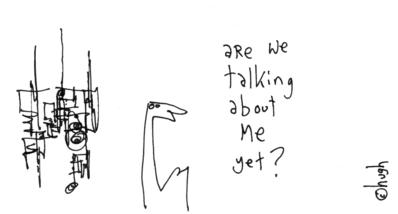 Hugh Macleod refers to a social object, as a node, a reason for meaningful conversation to take place.
Hugh Macleod refers to a social object, as a node, a reason for meaningful conversation to take place.
As an artist, entrepreneur and author, Hugh knows a thing or two about this fundamental truth. He lives by it. He creates art that people talk about, he creates social objects and coined the phrase.
Hugh says that marketing is not about likes on facebook or retweets. Instead, marketing is about creating these sharing devices called social objects.
We have to create things that become central points of discussion.Hugh says “social networks form around Social Objects, not the other way around”. So, “if your product is not a Social Object, why are you in business?”
This is serious insight for today’s marketer – and business owners.
“Somewhere along the line I figured out the easiest products to market are objects with “Sociability” baked-in. Products that allow people to have “conversations” with other folk.”
Social objects are worthy of being talked about. Social objects are good for businesses and their customers.
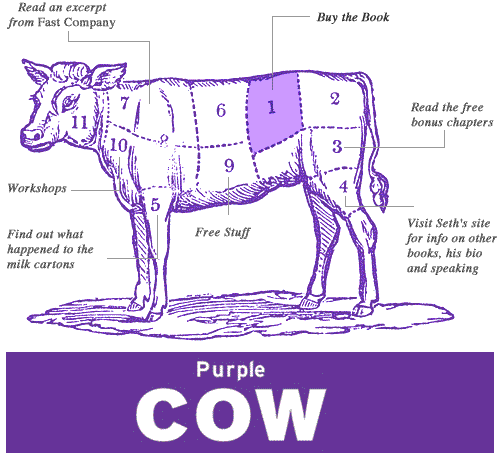 Seth Godin refers to this in his best-selling book “Purple Cow”. The purple cow is the remarkable element within your business, service or product that is worth talking about. It is the marketing built right into the product itself.
Seth Godin refers to this in his best-selling book “Purple Cow”. The purple cow is the remarkable element within your business, service or product that is worth talking about. It is the marketing built right into the product itself.
Novel idea right? Make something worth talking about.
In a blog post about how to be remarkable, Seth illustrates 9 truths about being remarkable. He says “Remarkable doesn’t mean remarkable to you. It means remarkable to me. Am I going to make a remark about it? If not, then you’re average, and average is for losers. Being noticed is not the same as being remarkable. Running down the street naked will get you noticed, but it won’t accomplish much. It’s easy to pull off a stunt, but not useful.”
What Seth is saying is important.
We aren’t creating random junk that causes discussion just for the sake of it. Instead, we are creating meaningful connections that are worth talking about.
What if the product doesn’t seem to be remarkable?
Like a newspaper for example. How can we bring an emotional connection to the daily paper?
Wow, an attacking skinhead brings fear front and center and turns it into care in 30 short seconds. At the center, the promise of editorial integrity by the newspaper to give you a full story. This video was made in 1986 and still resonates today.
But, it’s a different time and place today – right?
We don’t love newspaper and this type of advertising, while good to prove a point like this, doesn’t help you see the bigger picture that includes today’s users, readers, and distracted lifestyles.
Ok, how about the same newspaper – the Guardian – circa 2012.
Longer, more complex, but relevant and captivating.
I’d argue the complexity makes it a bit harder to embrace as a social object. But it’s a great example of the same product staying connected in today’s world through a story we can relate with. While we may not smile or laugh, we nod our heads in agreement, understanding, and approving. We see the world is tough, bad people do bad things, and we have an opinion about it.
It connects and resonates.
How do we accomplish this for ourselves?
Questions to drive connections and Lovemarks
Kevin Roberts, CEO of Saatchi and Saatchi has an informed opinion after 40+ years in big advertising working on the inside of giants like Gillette, P&G, and Pepsi, until becoming the big cheese at Saatchi and Saatchi Worldwide.
Kevin boils it down to three simple questions:
- Do you want to see it again?
- Do you want to share it?
- Do you want to improve it?
Ask these questions to get clued into today’s best marketing efforts.
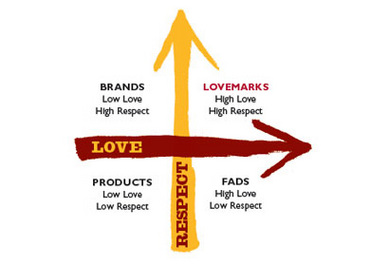 Of course, this is advice given from the man who strongly believes advertising is about emotional storytelling, not facts and figures. This is the person responsible for the Love / Respect axis that illustrates brands becoming Lovemarks.
Of course, this is advice given from the man who strongly believes advertising is about emotional storytelling, not facts and figures. This is the person responsible for the Love / Respect axis that illustrates brands becoming Lovemarks.
In this hour long agency presentation, Kevin explains how these three questions are central to their advertising agency of more than 6,000 employees.
Kevin tells us marketing is dead.
The old ways of creating demand, awareness, and customers is dead. Now marketing is about creating a movement of people, inspiring them to join that movement for your brand, your business, your belief.
From his perspective, new is not what’s important, what’s important today is the now and everything is about happiness in the now.
We have moved from information to inspiration.
We must inspire, not just inform.
Today’s marketing is based on emotion not rational thinking.
Kevin warns that rational thinking leads to conclusions, to meetings, to consultants and to more emails. But emotional thinking leads to action.
In his book, Lovemarks: The future beyond brands, he tells us the three key elements of emotional story telling for the ultimate brand, the Lovemark, is to communicate with mystery, sensuality and intimacy.
This questionnaire gives you a great idea of how Kevin and the team at Saatchi and Saatchi see brands and define them as a Lovemark.
So, what does this all mean?
Conclusion
- To create something remarkable it has to connect with the customer – emotionally.
- Make it remarkable in the customers eyes, not yours alone, it’s not about you.
- Great marketing and great products are social objects worthy of conversation.
- Use stories to create humor, surprise, joy, sadness, and other emotional connections to give the world something that is liked, shared, and discussed.
- Create something you want to see again, participate in, and talk about.
- It’s no longer a stunt, an advertising gimmick; instead it’s a meaningful touch point where you are clearly inside the hearts and minds of your kind of people. It’s a way to say you get it and you want to be a part of the discussion.
- It’s not logic, it’s emotion.
- inspire, don’t inform.
What are you creating that’s vulnerable or inspiring?
Speak up and let me know where you stand on this.
Facts? Emotions? Tell me.
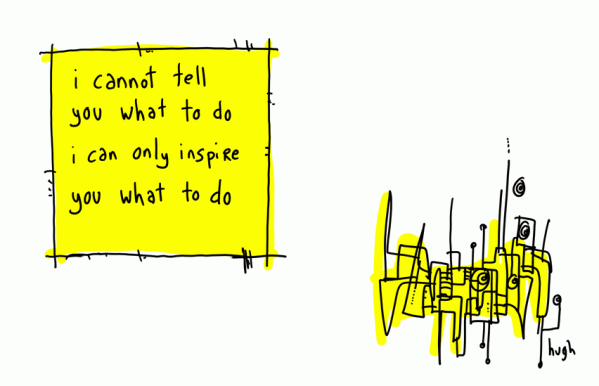
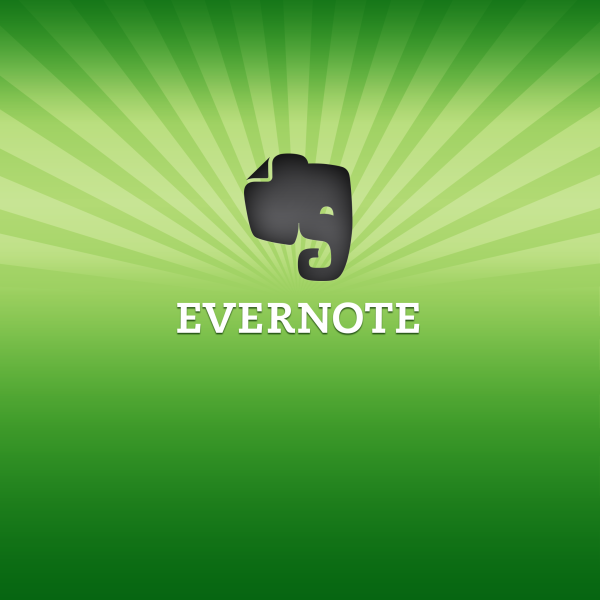
 Amateurs mistake tactics for technique and mechanics for mastery.
Amateurs mistake tactics for technique and mechanics for mastery. Reverse engineering may just be the change your content marketing strategy needed to go to the next level.
Reverse engineering may just be the change your content marketing strategy needed to go to the next level.





